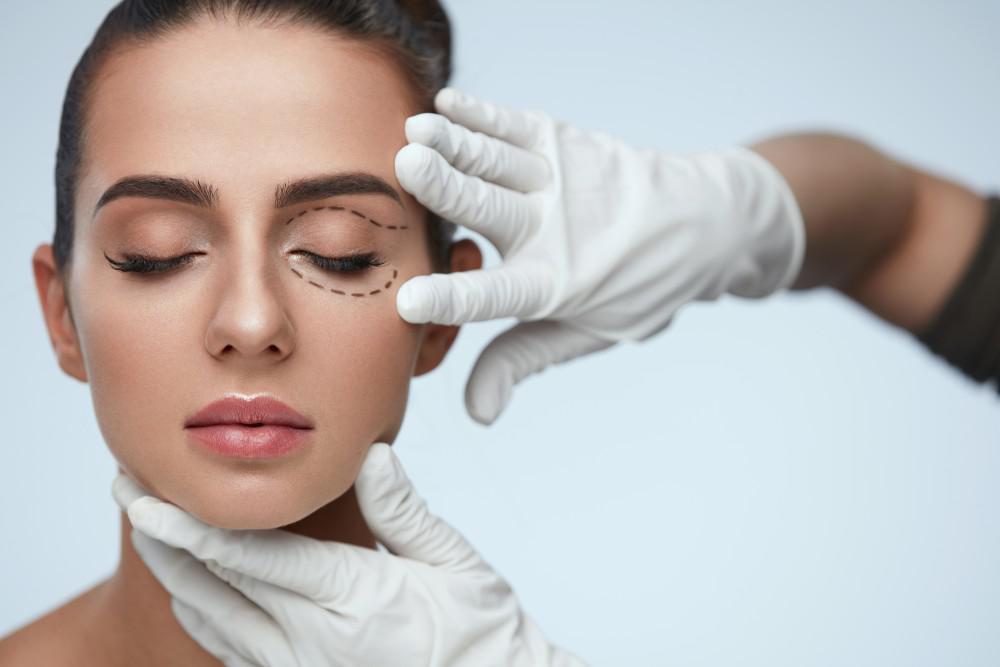Like other areas of your face, your eyelids change in appearance as you age. As skin loses elasticity, gravity causes excess skin and fat to accumulate around the eyes, leading to several common concerns: saggy upper eyelids that create heaviness, large under-eye bags caused by excess fatty deposits, heavy skin around the eyes, and excess skin on lower eyelids. These changes make you look older than you feel. That’s where eyelid rejuvenation procedures come into the picture.
Eyelid rejuvenation refers to various procedures aimed at improving the appearance and sometimes function of the eyelids. While surgical blepharoplasty provides the most dramatic results, our oculoplastic and reconstructive surgeon Dr. Raymond Douglas– an expert with experience in both initial and revision blepharoplasty- can transform the whole appearance of your face. You’d be amazed at how much of a difference eyelid rejuvenation surgery makes in achieving your anti-aging goals.
Dr. Douglas provides rejuvenation treatment for eyelids to new and existing patients living in and around Beverly Hills, Los Angeles, California. Here’s what he wants you to know about the benefits of eyelid rejuvenation.
Surgical and Non-Surgical Eyelid Rejuvenation Options
Blepharoplasty is a surgical technique that cosmetically enhances the appearance of the eyes by removing or repositioning excess skin, fat, and muscle from the upper and/or lower eyelids. Dr. Douglas completely customizes your treatment plan to suit your unique needs and goals.
However, various non-surgical treatments are also available, including dermal fillers to address volume loss around the eyes, laser treatments to improve skin texture and stimulate collagen production, chemical peels for smoother texture, and radiofrequency or ultrasound therapies to tighten tissues. Often, a combination of treatments may be recommended for optimal results.
How We Help With Drooping Eyelids
Your eyelid skin loses fullness and elasticity as you age. In areas like your eyelids, this can create an appearance of sagging or drooping. If your upper eyelids are affected, they may even hang down over your eyes, impacting your field of vision.
Upper Blepharoplasty
Upper blepharoplasty focuses on removing saggy skin from the upper eyelids. During the procedure, Dr. Douglas removes tissue and fat from the upper lids by making small incisions in the natural crease of the eye. He then repositions and manipulates the tissue in a way that follows the natural curvature of your bone structure. We can reposition fat pads and focus on possibly removing fat. The goal is to preserve as much natural tissue as possible while creating a fresher, younger-looking appearance. Surgery on your upper eyelid can reduce extra tissue, with results lasting from 5-7 years or longer.
Lower Blepharoplasty
Lower blepharoplasty targets the saggy pockets of fat and tissue underneath your eyes that can make you look tired and older. After making tiny incisions, Dr. Douglas carefully lifts the skin and underlying tissue to remove or reposition the fat underneath your eyes. He can then use this fat to fill in hollows or reduce puffiness.
Depending on your unique case, Dr. Douglas may recommend one procedure or a combination of both. He can also combine blepharoplasty with a brow lift to enhance your results.
Dr. Douglas specializes in aesthetic procedures for Asian eyes, and has personal experience practicing in Asia.
What to Expect Before, During, and After Your Eyelid Surgery
Before eyelid surgery, Dr. Douglas discusses the risks and benefits of the procedure, making sure you have a realistic expectation of your results. He may recommend intravenous sedation or general anesthesia during your operation.
For upper eyelid surgery, Dr. Douglas uses small incisions to remove excess eyelid skin and tissue. For surgery on your lower eyelids, Dr. Douglas makes a small incision right below your lash line, or works through an incision on the underside of your lower eyelid. You won’t have visible scarring after you’ve healed from your procedure.
Eyelid rejuvenation surgery only requires a short recovery time. Mild bruising and swelling around the eyes are perfectly normal side effects. You might need medications for pain relief, or items like cold packs or artificial tears, following your procedure. In the first 48 hours, you’ll use cool compresses to reduce the bruising and swelling around your eyes and face. Keep your head elevated whenever possible – you may consider sleeping on two pillows for the first few days.
Your bandages are removed after a few days, and stitches can come out after about a week, or naturally absorb into your eyelid skin. Just 7-10 days after your procedure, you can return to normal activities. To ensure you heal properly, avoid strenuous activity until Dr. Douglas clears you for exercise. Most of your side effects vanish after two weeks.
Dr. Douglas understands that patients seek eyelid rejuvenation for different reasons – some primarily for cosmetic improvement to achieve a more youthful and rested appearance, while others need functional improvement to restore an unobstructed visual field. Your specific goals and expectations will guide the treatment approach and help determine whether surgical blepharoplasty, non-surgical treatments, or a combination would be most appropriate for your needs.
To find out if you could be a good candidate for eyelid rejuvenation treatment this spring, get in touch with Dr. Douglas now. You can schedule your appointment by calling our Beverly Hills office today.




